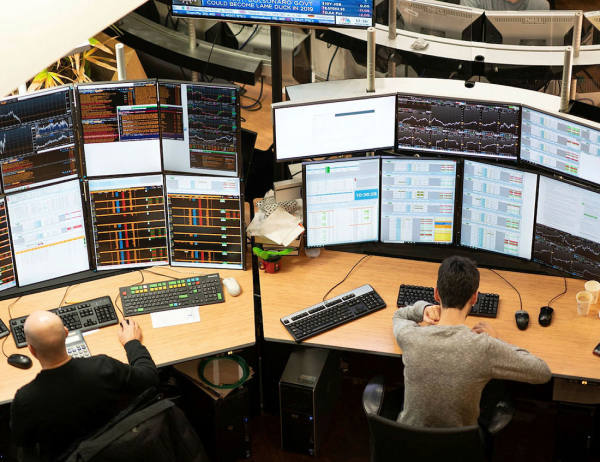- The FTSE 100 ends 2022 in the black
- That doesn’t mean passive won out
- Lots of idea-generating content…
Whenever a news presenter says, 'stocks fell today', they are usually accurate – albeit in a roundabout way.
Because 'stocks' are normally shorthand for a stock index, what the newscaster is usually saying is 'a basket of the market’s largest stocks fell today'. More accurately, because that 'basket of the market’s largest stocks' is typically composed of stocks held in proportion to their relative size, what they are saying is 'a basket of the market’s largest stocks, weighted by their market capitalisation, fell today'.
From an editorial perspective, this framing makes sense. If the FTSE 100 falls 5 per cent today, we know that the combined market value of the London Stock Exchange’s 100 largest companies has dropped 5 per cent. If the average FTSE 100 constituent falls 5 per cent today, it is still possible – though statistically unlikely – that the index saw its total market value increase by 5 per cent.
But this isn’t the only way to look at stock indices, whose features are often heavily distorted by their largest members.
Given the £1.6 trillion market value of Saudi Aramco (SA:2222) equates to about three-quarters of the Saudi stock exchange’s total value, it makes sense for index provider MSCI to place a maximum weighting of 15 per cent per constituent in its Tadawul 30 Index. Without this cap, it would be hard to understand the performance of Saudi equities beyond one company, important though it may be.
The performance of capitalisation-weighted indices can also obscure the experience and style preferences of the average investor.
Throughout this issue, you will find plenty of references to how 'stocks fell in 2022'. That is in part because most stocks did fall in 2022: a UK investor who randomly selected a main market or Aim-traded stock at the beginning of the year would, on average, be staring at a loss today, whether or not they re-invested dividends.
Similarly, any US investor who wildly threw a dart at a list of S&P 500 stocks on 1 January and immediately fired up their Robinhood app to buy whatever they hit, would likely be in the red. Whether in simple or total return terms, the median and mean share price returns for constituents of America’s blue-chip index are negative.
But this gives us less than half the picture. While a randomly selected FTSE 100 constituent would have lost money this year, the index is up 1.3 per cent in 2022. Same-sized bets on each of the Aim 100’s members may have collectively shed 22 per cent of their value, but bigger relative falls for larger constituents mean losses would be substantially worse for a market-weighted exchange traded fund equivalent.
In the US, a similar phenomenon meant that equal-weighted S&P 500 trackers (or our dart-throwing friend) will have, on average, outperformed the classic capitalisation-weighted index by between 5 and 7 percentage points.
Anyone who claims that 2022 vindicated passive equity investing therefore needs to spell out exactly what it is they are measuring.
Granted, the shares of large energy, mining, tobacco and bank companies helped push the FTSE 100 into the black this year, at a time when most actively managed UK large-cap funds are down. The fact that just 11.2 per cent of actively managed European equity funds outperformed the S&P Europe 350 in the 12 months to June – which the index-provider calculates is only a little worse than the five- and 10-year averages – also suggests the continent’s professional stockpickers are blind to certain sectors.
But on a total return basis, only a quarter of FTSE All-Share constituents and a fifth of Aim-traded companies are in positive territory since January. The same is true for just a third of companies in the S&P 500. If passive instruments have provided any shelter of late, this might be due to their unique self-righting qualities. Or it could be a fluke.
Either way, if this new market regime increases the dispersion of equity returns, a selective approach might have just become a lot more important.
| Passive vs. active (MC vs EW, %) | Random vs. active (Median vs EW, %) | Random vs. passive (Median vs MC, %) | |||||||
| Index | Total return | Simple return | Divs received | Total return | Simple return | Divs received | Total return | Simple return | Divs received |
| FTSE All-Share | 12.10 | 14.80 | 12.03 | -0.85 | -0.09 | -0.76 | -12.95 | -14.89 | -12.79 |
| FTSE 100 | 8.05 | 11.22 | 8.03 | -2.49 | -3.01 | -2.22 | -10.54 | -14.24 | -10.25 |
| Aim All-Share | -6.79 | -6.04 | -6.83 | -6.13 | -5.67 | -5.95 | 0.66 | 0.37 | 0.88 |
| Aim 100 | -11.56 | -10.27 | -11.68 | -0.25 | -2.48 | -0.59 | 11.32 | 7.79 | 11.09 |
| S&P 500 (£) | -9.29 | -7.42 | -9.29 | -2.24 | -1.61 | -2.33 | 7.05 | 5.81 | 6.96 |
| S&P 500 ($) | -8.55 | -6.85 | -8.54 | -2.02 | -1.44 | -2.10 | 6.52 | 5.40 | 6.44 |
| Source: FactSet. YTD returns, accurate as of 9 Dec 2022. MC = Market cap-weighted index; EW = Equal-weighted index; Median = median constituent. | |||||||||





.png?source=invchron&width=600)
